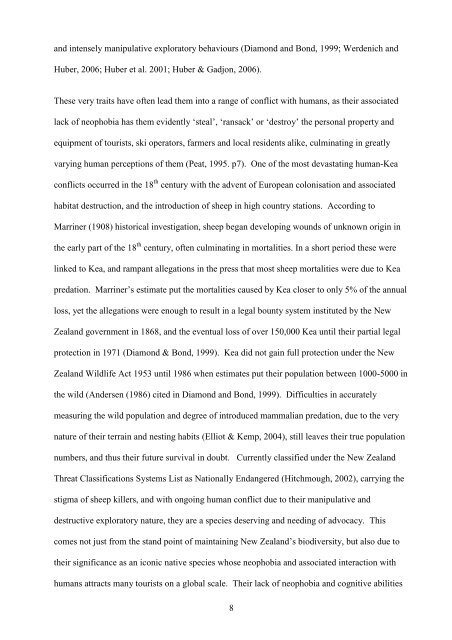The Dynamics of Kea Behaviour and Interpretive Signage on Visitor ...
The Dynamics of Kea Behaviour and Interpretive Signage on Visitor ...
The Dynamics of Kea Behaviour and Interpretive Signage on Visitor ...
You also want an ePaper? Increase the reach of your titles
YUMPU automatically turns print PDFs into web optimized ePapers that Google loves.
<str<strong>on</strong>g>and</str<strong>on</strong>g> intensely manipulative exploratory behaviours (Diam<strong>on</strong>d <str<strong>on</strong>g>and</str<strong>on</strong>g> B<strong>on</strong>d, 1999; Werdenich <str<strong>on</strong>g>and</str<strong>on</strong>g><br />
Huber, 2006; Huber et al. 2001; Huber & Gadj<strong>on</strong>, 2006).<br />
<str<strong>on</strong>g>The</str<strong>on</strong>g>se very traits have <str<strong>on</strong>g>of</str<strong>on</strong>g>ten lead them into a range <str<strong>on</strong>g>of</str<strong>on</strong>g> c<strong>on</strong>flict with humans, as their associated<br />
lack <str<strong>on</strong>g>of</str<strong>on</strong>g> neophobia has them evidently ‘steal’, ‘ransack’ or ‘destroy’ the pers<strong>on</strong>al property <str<strong>on</strong>g>and</str<strong>on</strong>g><br />
equipment <str<strong>on</strong>g>of</str<strong>on</strong>g> tourists, ski operators, farmers <str<strong>on</strong>g>and</str<strong>on</strong>g> local residents alike, culminating in greatly<br />
varying human percepti<strong>on</strong>s <str<strong>on</strong>g>of</str<strong>on</strong>g> them (Peat, 1995. p7). One <str<strong>on</strong>g>of</str<strong>on</strong>g> the most devastating human-<str<strong>on</strong>g>Kea</str<strong>on</strong>g><br />
c<strong>on</strong>flicts occurred in the 18 th century with the advent <str<strong>on</strong>g>of</str<strong>on</strong>g> European col<strong>on</strong>isati<strong>on</strong> <str<strong>on</strong>g>and</str<strong>on</strong>g> associated<br />
habitat destructi<strong>on</strong>, <str<strong>on</strong>g>and</str<strong>on</strong>g> the introducti<strong>on</strong> <str<strong>on</strong>g>of</str<strong>on</strong>g> sheep in high country stati<strong>on</strong>s. According to<br />
Marriner (1908) historical investigati<strong>on</strong>, sheep began developing wounds <str<strong>on</strong>g>of</str<strong>on</strong>g> unknown origin in<br />
the early part <str<strong>on</strong>g>of</str<strong>on</strong>g> the 18 th century, <str<strong>on</strong>g>of</str<strong>on</strong>g>ten culminating in mortalities. In a short period these were<br />
linked to <str<strong>on</strong>g>Kea</str<strong>on</strong>g>, <str<strong>on</strong>g>and</str<strong>on</strong>g> rampant allegati<strong>on</strong>s in the press that most sheep mortalities were due to <str<strong>on</strong>g>Kea</str<strong>on</strong>g><br />
predati<strong>on</strong>. Marriner’s estimate put the mortalities caused by <str<strong>on</strong>g>Kea</str<strong>on</strong>g> closer to <strong>on</strong>ly 5% <str<strong>on</strong>g>of</str<strong>on</strong>g> the annual<br />
loss, yet the allegati<strong>on</strong>s were enough to result in a legal bounty system instituted by the New<br />
Zeal<str<strong>on</strong>g>and</str<strong>on</strong>g> government in 1868, <str<strong>on</strong>g>and</str<strong>on</strong>g> the eventual loss <str<strong>on</strong>g>of</str<strong>on</strong>g> over 150,000 <str<strong>on</strong>g>Kea</str<strong>on</strong>g> until their partial legal<br />
protecti<strong>on</strong> in 1971 (Diam<strong>on</strong>d & B<strong>on</strong>d, 1999). <str<strong>on</strong>g>Kea</str<strong>on</strong>g> did not gain full protecti<strong>on</strong> under the New<br />
Zeal<str<strong>on</strong>g>and</str<strong>on</strong>g> Wildlife Act 1953 until 1986 when estimates put their populati<strong>on</strong> between 1000-5000 in<br />
the wild (Andersen (1986) cited in Diam<strong>on</strong>d <str<strong>on</strong>g>and</str<strong>on</strong>g> B<strong>on</strong>d, 1999). Difficulties in accurately<br />
measuring the wild populati<strong>on</strong> <str<strong>on</strong>g>and</str<strong>on</strong>g> degree <str<strong>on</strong>g>of</str<strong>on</strong>g> introduced mammalian predati<strong>on</strong>, due to the very<br />
nature <str<strong>on</strong>g>of</str<strong>on</strong>g> their terrain <str<strong>on</strong>g>and</str<strong>on</strong>g> nesting habits (Elliot & Kemp, 2004), still leaves their true populati<strong>on</strong><br />
numbers, <str<strong>on</strong>g>and</str<strong>on</strong>g> thus their future survival in doubt. Currently classified under the New Zeal<str<strong>on</strong>g>and</str<strong>on</strong>g><br />
Threat Classificati<strong>on</strong>s Systems List as Nati<strong>on</strong>ally Endangered (Hitchmough, 2002), carrying the<br />
stigma <str<strong>on</strong>g>of</str<strong>on</strong>g> sheep killers, <str<strong>on</strong>g>and</str<strong>on</strong>g> with <strong>on</strong>going human c<strong>on</strong>flict due to their manipulative <str<strong>on</strong>g>and</str<strong>on</strong>g><br />
destructive exploratory nature, they are a species deserving <str<strong>on</strong>g>and</str<strong>on</strong>g> needing <str<strong>on</strong>g>of</str<strong>on</strong>g> advocacy. This<br />
comes not just from the st<str<strong>on</strong>g>and</str<strong>on</strong>g> point <str<strong>on</strong>g>of</str<strong>on</strong>g> maintaining New Zeal<str<strong>on</strong>g>and</str<strong>on</strong>g>’s biodiversity, but also due to<br />
their significance as an ic<strong>on</strong>ic native species whose neophobia <str<strong>on</strong>g>and</str<strong>on</strong>g> associated interacti<strong>on</strong> with<br />
humans attracts many tourists <strong>on</strong> a global scale. <str<strong>on</strong>g>The</str<strong>on</strong>g>ir lack <str<strong>on</strong>g>of</str<strong>on</strong>g> neophobia <str<strong>on</strong>g>and</str<strong>on</strong>g> cognitive abilities<br />
8












